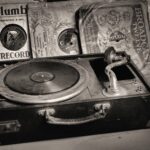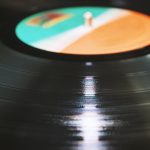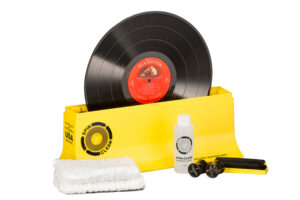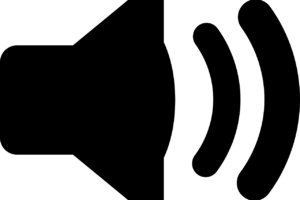Phono preamps are strange. First of all, a non-audiophile–the target of this and all equipment articles at TDMB–may wonder why it’s necessary to have an amplifier before, well, the amplifier. The next strange thing about preamps is that precisely where they are physically — and in what they are contained — matters little. All that is necessary is where they are in the electronic path from the record to your ears.
It’s an interesting topic. The goals of this article are to describe what a phono preamp does, provide advice on finding the best phono preamp and provide at least a vague notion of the likely price point for these vital devices. The goal is to provide information that will increase the chances that you’ll buy a device with which you are happy.
Finding the Best Phono Preamp: Key Questions
Phono preamplifiers — which in the phono world also are called phono stages — are a common audio tool. The term is a bit tricky in relation to analog HiFi equipment because the preamps for this utilization are specialized. There is no difference between phono preamps and phono stages.

A phono preamps’ position in the hierarchy of an analog HiFi setup is more or less summed up by its name. Phono preamps — or the circuitry that performs the task — sit between the cartridge and amplifier. It can be a housed in a separate unit (the configuration dealt with in this article), housed in the turntable or in the amplifier (in what is called an integrated amplifier). The fact that this circuitry may be in a number of places suggests that you may already have a preamp in your system that you don’t know about.
If all else is equal, preamps that are not collocated with other equipment are preferred. For one thing, squeezing electronic goings-on from multiple functions into one housing can lead to signal contamination (signal leakage and crosstalk). A separate unit also makes it easier and less expensive to upgrade the system. However, entry level folks or those not overly interested in building their systems piece by piece will do fine with built in phono preamps co-located with either the turntable or integrated amplifier.
Wherever it is and whoever it works with, the circuitry’s primary job is to amplify very weak signals coming off the vinyl to the point that they are robust enough to be processed by the main amplifier, which sometimes is called a power amp.
The other end of the cantilever connects to four coils that in turn connect to tiny magnets. The stylus bounces around the grooves of the record as it turns. This causes the cantilever to move the magnets through an electrical field, creating minuscule currents. These currents — the electronic representation of the physical grooves of the record — are sent to the phono preamp, amplified and sent to the power amp.
— Look for preamps that help in analog to digital conversion. It’s a great extra feature that can make your vinyl record collection portable
— Determine whether you have a moving coil or moving magnet cartridge and buy the corresponding preamp
— Understand what your needs are. This is a very broad category and you could end up overpaying[/su_box]
A key difference between phono preamps and the other types of preamps is that they have an extra job. Creating a phonograph record is a physical act, and signals in the lower frequencies (bass guitars, James Earl Jones’ voice) are broader and take up more space on a record. That means that the recording time would be reduced if these signals they were fully represented on the disc. In the 1940s, the Recording Industry Association of America found a way to avoid pressing those lower frequencies into the vinyl records. The preamp’s extra job is to run the RIAA equalization process that restores the lower frequencies.
A Crowded Field of Preamp Makers
A quick look at the top sellers at Amazon and surfing some sites on the web suggests two things about the phono preamp market: There are a lot of companies making these widgets and the gulf in prices is great.
Here are some names to keep in mind: Rolls, Schiit Audio, Little Bear, Pyle, Fosi, Pro-Ject, Rega, Turntable Lab, Yamaha, Vincent, Ompait, Cambridge Audio, ARTessories, Mobile Fidelity, Bellari, Art Precision, NAD and Graham Slee.
That’s a lot of companies and, I fear, simply listing them is of marginal use. However, if you are shopping and see any devices from these manufacturers you can be fairly certain that they are not just throwing one or two products into the market to see how they do. This list is not exhaustive. The best advice is to google a name you don’t recognize to see if they are players or wannabes.
The tremendous gulf between the highest and lowest prices – from about $30 to more than $1,000 – suggests that a careless shopping easily could end paying for things you not needed or skipping things they do. A $1,000 preamp almost certainly goes way beyond audio to cover the entire home theater waterfront with extra functions and top-shelf elements and construction. If that’s what you need, go for it. If affordable phono equipment is what you want (perhaps all you want to do is revive an old turntable to play your forty year-old vinyl you can get by for far less.
Key Specs
Following are a brief description of key specs and what Pyle noted for its PP999 phono preamp. I’m structuring this article around that device simply because it was the first one that came up when I Googled Amazon’s best sellers.
Output Level: This is the boost provided by the preamp to the signal arriving from the cartridge and delivered to the amplifier. It is measured in volts. The output level of the PP999 is 2 Volts.
Signal to noise ratio: SNR is an important measure that compares the intended, perfect signal against the noise – imperfections and background noise — that are caused by a variety of factors. A-WTD stands for A-weighted. It is a scale of measuring S/R ratio that is most attuned to human hearing. The SNR of the PP999 is 70 dB (A-WTD).
Total harmonic distortion: It’s amazing how quickly these things become difficult to understand. A typical example is this paragraph by David Williams at All About Circuits from a few years ago:
A voltage or current that is purely sinusoidal has no harmonic distortion because it is a signal consisting of a single frequency. A voltage or current that is periodic but not purely sinusoidal will have higher frequency components in it contributing to the harmonic distortion of the signal. In general, the less that a periodic signal looks like a sine wave, the stronger the harmonic components are and the more harmonic distortion it will have.
Got it? The idea seems to be this: There is no harmonic distortion when somebody sings or plays a single note on an instrument. The sine wave (the graph of the waveform over time) created will be perfect (i.e., not harmonically distorted) because it is the only sound being measured. If, however, if a second instrument or singer enters the picture and doesn’t precisely match the first — i.e. provides sound at a different frequency — the curve becomes imperfect. That’s harmonic distortion. THD for the Pyle PP999 is 0.08 for 1 KHz 3 mV Input.

Stevie Ray Vaughan is a legendary blues/rock guitarist from Austin, Texas. Check out an interview about great Vaughan with Craig Hopkins, author of the Vaughan biography”Day by Day, Night After Night.” Vaughan is pictured above flanked by the other members of his most famous band, Double Trouble. Drummer Chris Layton is on the left and bassist Tommy Shannon is on the right.[/su_box]
A related spec is total harmonic distortion + noise (THD+N), which is sort of a grand summation of all the imperfections that can hurt the sonic performance of an electronic device, including a preamp.
Frequency Response: Frequency response is the range of sound that the device can reproduce. Human’s ability to hear sound ranges from 20Hz (low frequency sounds) to about 20kHz (high frequency sounds). Those numbers are the norm for women and kids. Middle age and older men struggle (so what else is new?). This post at Alesis says that frequency response is the most important thing about three times. Devices that can’t sustain those numbers don’t reproduce sound accurately. It seems that the PP999 hits the mark precisely.
This chart is an attempt to summarize some of the important specifications. In a way, it’s also a way to show the shortcomings of relying too much of these numbers in an effort to buy the device that will provide the best sound quality.
[su_box title=”Finding the Best Phono Preamp: Some Key Specs” style=”soft” box_color=”#fafbd3″ title_color=”#090909″ radius=”10″]The models in addition to the Pyle PP999: the Schiit Mani, the Fosi Audio Box X1, the Little Bear T7 Vacuum Tube Mini Phono Stage, the Pro-Ject Record Box E and the Rega Fono Mini A2D MK2.[/su_box]
There obviously are several problems (or shall we say challenges) with this chart. It’s not clear that the vendors are making totally direct comparisons. They offer a number or percentage, but add a qualifier that may or may not slightly upset the relevance of one measure to the other. We also are not told to what degree differences between the properties being measured actually impact the sound.
That doesn’t mean that the specifications are useless to the uneducated or don’t impact sound quality, however. Between boosting the initial signals and RIAA equalization, preamps are pivotal. In general, it’s obviously better to buy the device with the best numbers (including price tag, of course). But those numbers should just be one of many considerations.
At the end of the day, it’s subjective. In 2018, a video blogger who calls himself Audiorpheus did a comparison of several phono preamps that had similar price tags. The PP 999 came in next to last in his assessment. What came through (besides the fact that this fellow has good taste in music) is that the it’s difficult to hear the difference between best phono preamps and that which is “better” is highly subjective.
Entry level preamps are quite inexpensive and may be a good spot to save some money. It pays, however, not to think only of finding a budget preamp, since these devices are very important. The best advice is to understand precisely what you need.
















Recent Comments